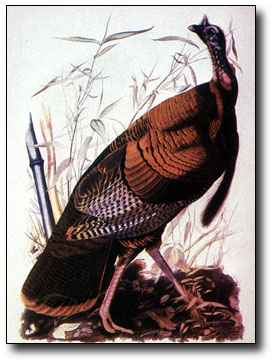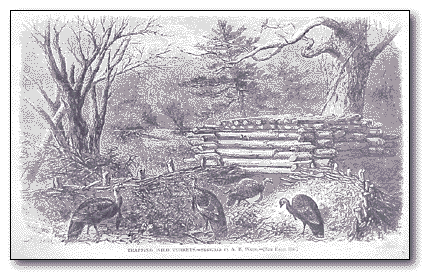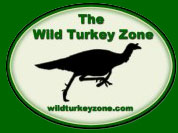|
Early
Colonial American History of the Wild Turkey
 In
1620, the Pilgrims disembarked from
the Mayflower onto the "New World," currently
known as Plymouth, Massachusetts. As colonist began
to search for sources of food, they met up with Northeastern
Native Americans. There new neighbors shared their
knowledge of hunting large fowl. The colonist were
surprised to see turkey cocks gobbling and strutting
on this land similar to the domesticated ones they
brought from England. The delicious meat of the wild
turkey was an important and an abundant food supply
for both Indians and settlers. Soon the New World
Pilgrims were cross breeding both stocks of Turkeys
at the Plymouth Plantation. In
1620, the Pilgrims disembarked from
the Mayflower onto the "New World," currently
known as Plymouth, Massachusetts. As colonist began
to search for sources of food, they met up with Northeastern
Native Americans. There new neighbors shared their
knowledge of hunting large fowl. The colonist were
surprised to see turkey cocks gobbling and strutting
on this land similar to the domesticated ones they
brought from England. The delicious meat of the wild
turkey was an important and an abundant food supply
for both Indians and settlers. Soon the New World
Pilgrims were cross breeding both stocks of Turkeys
at the Plymouth Plantation.
Some experts think that
roast turkey adorned the first Thanksgiving dinner
the Pilgrims had in 1621. Others credit the settlers
of Virginia's Jamestown with celebrating the first
Thanksgiving as their version of England's ancient
Harvest Home Festival.
Wild
Turkey as Our National Bird
On July 4 1776, the First Continental
Congress selected a committee to design the Great
Seal of the United States of America. It was the task
of three founding fathers: Benjamin Franklin, John
Adams, and Thomas Jefferson to select a political
icon that best reflected the new country.
Benjamin Franklin used his legendary
humor to rebut John Adams nomination of the Bald Eagle
similar to Germany's Imperial Eagle Sable. Franklin
considered the turkey, not the eagle, as a fitting
emblem for the Great Seal. To his dismay, Franklin's
turkey was outvoted by a large margin. In a letter
to his daughter he wrote:
"For my own part I wish the Bald Eagle had
not been chosen the Representative of our Country.
He is a Bird of bad moral Character. He does not
get his Living honestly. You may have seen him perched
on some dead Tree near the River, where, too lazy
to fish for himself, he watches the Labour of the
Fishing Hawk; and when that diligent Bird has at
length taken a Fish, and is bearing it to his Nest
for the Support of his Mate and young Ones, the
Bald Eagle pursues him and takes it from him.
With all this Injustice, he is
never in good Case but like those among Men who
live by Sharping & Robbing he is generally poor
and often very lousy. Besides he is a rank Coward:
The little King Bird not bigger than a Sparrow attacks
him boldly and drives him out of the District. He
is therefore by no means a proper Emblem for the
brave and honest Cincinnati of America who have
driven all the King birds from our Country....
I am on this account not displeased
that the Figure is not known as a Bald Eagle, but
looks more like a Turkey. For the Truth the Turkey
is in Comparison a much more respectable Bird, and
withal a true original Native of America... He is
besides, though a little vain & silly, a Bird
of Courage, and would not hesitate to attack a Grenadier
of the British Guards who should presume to invade
his Farm Yard with a Red Coat on."
Brilliant artist and naturalist,
John James Audubon thought highly of the patriotic
qualities of the turkey.
"Male turkeys can turn their
heads red, white and blue by controlling the flow
of oxygen to their heads while strutting."
Turkeys Endangered
 Although
wild turkeys could fly fast, they couldn't fly far,
so they became easy shots for hunters. Once American
pioneers discovered turkeys were not blessed with
either adequate vision or high IQs, and could be easily
trapped, they became the settler's primary source
of food. Although
wild turkeys could fly fast, they couldn't fly far,
so they became easy shots for hunters. Once American
pioneers discovered turkeys were not blessed with
either adequate vision or high IQs, and could be easily
trapped, they became the settler's primary source
of food.
The turkey trap was a simple contraption
that consisted of a covered pen with a turkey-sized
tunnel dug underneath one wall. On the ground outside,
a trail of corn led from the thicket to the tunnel
to the interior of the pen. The unsuspecting turkey
would peck up the corn, go inside the pen and become
so flustered it would be unable to find its way out.
As pioneers pushed west and cut and
cleared virgin forests, the turkey's habitat changed
and wild turkey numbers dwindled. In the late 1700s,
turkeys were harvested without restraint and marketed
for human consumption. (Some historical reports mention
that hens sold for 6 cents apiece while big gobblers
brought a quarter at game markets). Wild turkeys were
so plentiful; in fact, people looked down on turkey
as food suitable for the lower classes. Men of means,
however, encouraged turkey breeding to insure that
turkey feathers-dyed to decorate their wives' hats,
dresses and coats-remained in plentiful supply. By
the mid 1800s the Civil War brought a shortage of
food and the big bird had been eliminated from nearly
half of its original range.
In 1840 J J Audubon wrote, as to the
turkey's status in his time:
"The unsettled parts of
the States of Ohio, Kentucky, Illinois, and Indiana,
an immense extent of country to the north-west of
these districts, upon the Mississippi and Missouri,
and the vast regions drained by these rivers from
their confluence to Louisiana, including the wooded
parts of Arkansas, Tennessee, and Alabama, are the
most abundantly supplied with this magnificent bird.
It is less plentiful in Georgia and the Carolinas,
becomes still scarcer in Virginia and Pennsylvania,
and is now very rarely seen to the eastward of the
last-mentioned States. In the course of my ramble
through Long Island, the State of New York, and
the country around the Lakes, I did not meet with
a single individual, although I was informed that
some exist in those parts. At the time when I removed
to Kentucky, rather more than a fourth of a century
ago, Turkeys were so abundant that the price of
one in the market was not equal to that of a common
barn fowl now. I have seen them offered for the
sum of three pence each, the birds weighing from
ten to twelve pounds. A first-rate Turkey, weighing
from twenty-five to thirty pounds avoirdupois, was
considered well sold when it brought a quarter of
a dollar."
|

